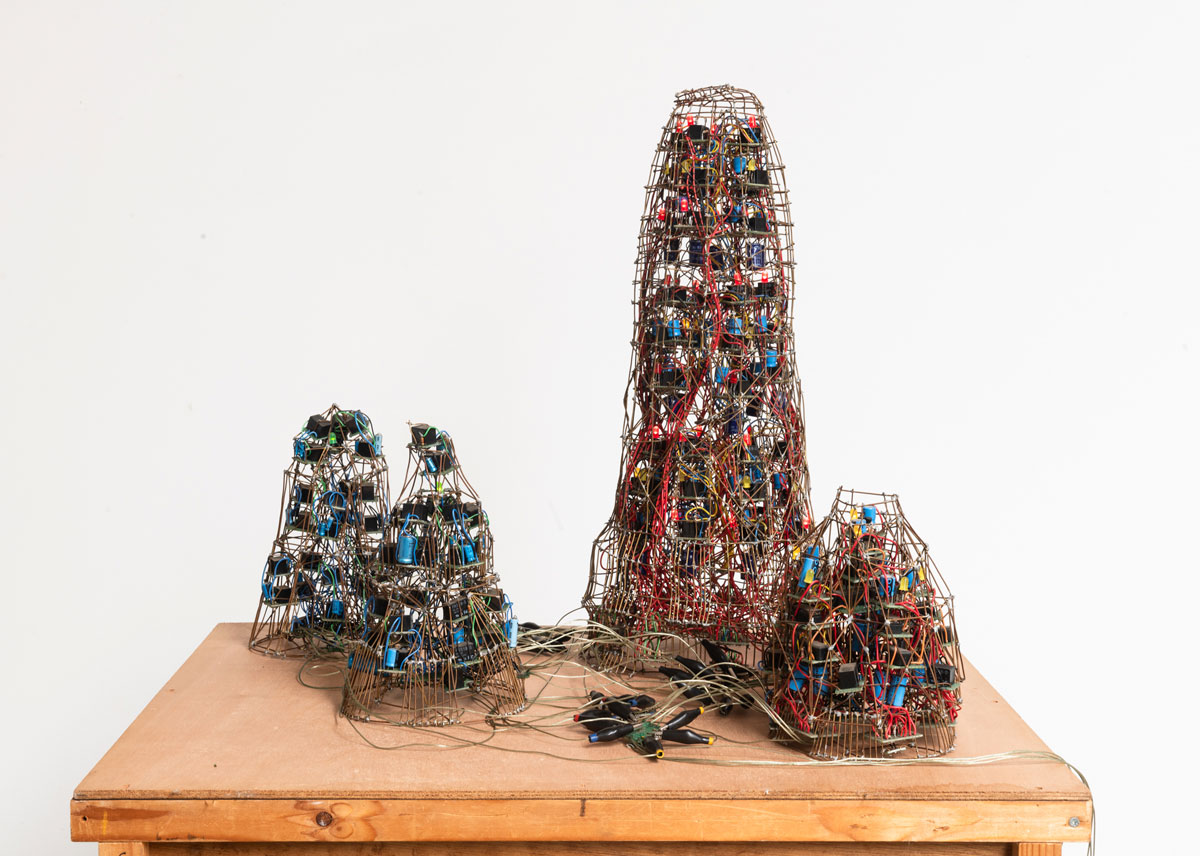In the exhibition Hyfen BLWDRK, it is up to the viewer to freely decide where a sound ends and an image begins. New sources will be discovered emerging from the core of artistic experimentation. Together with a diverse group of critical artists, we will explore the red or rather blue threads, the hyphae, of an underlying mycelial blueprint brought together by OFF OFF OFF, 10532 Atelierhuis, CC Palethe and Musica Impulse Centre.
This exhibition features artworks in which living organisms are transformed by the immaterial. Like plants, changes in shape and construction occur under the influence of or in the absence of light. The artists examine microscopic organisms, macroscopic superclusters and temporal processes subject to meteorological phenomena.
Josef Ramaseder (1956 – 2022, Linz)

At first glance, the photographs of Josef Ramaseder (1956 – 2022, Linz) look like photograms. However, his “Sporedust Paintings”, a dozen of which can be seen at the exhibition, were not made in the darkroom but in a daylight studio. Ramaseders images are made by placing kilos of mushrooms on specially made “scatter boxes”. Over time, the mushrooms release the spores and they fall onto the underlying carrier material. That is why you can also call these “Ramaseer graphs” “mycograms”, derived from “mycene”, the ancient Greek word for mushroom.
The origin of the name mycelium is linked to the Greek city of Mycenae on the Peloponnese peninsula. The myth goes that Perseus pulled a mushroom out of the ground, from which a spring sprang forth. The Ancient Greek word for mushroom became the name of the city: Mycenae. Later, scientists used this name to refer to the fungus gland, the underground part of the mushroom.
Gertrude Moser-Wagner (1953, Murau in Styria)

Gertrude Moser-Wagner (1953, Murau in Styria) created her so-called “Soil Sample Series” in the years 1998-2000. These resulted from a collaboration with natural scientists in Budweis, Göttingen and Bologna. Material soil was analysed and artistically interpreted. The first project was “Decomposition”, of which five black-and-white Diasec photographs from a series of 12 are on display at the exhibition. The photographs show a fusion of black-and-white microscope shots, under polarised light, of an extremely fine cross-section of a piece of earth containing Moser-Wagner’s carefully copied drawings of what she saw through the microscope.
The idea for the work originated during a visit to the Academy of Sciences in Budweis and the University of Göttingen, where the department of developmental biology focused on the genetically researched nematode (worm), or rather the mutant ROL-6, which is created in the laboratory.
Maria Blondeel (1963, Halle)

Maria Blondeel (1963, Halle) shows works with cables, sensors and artefacts from her BLWDRKlank archive. In 1995, Blondeel developed her spatial ‘sculptural’ projection screens. This produced seemingly chaotic installations as seen in the video of G (Dark Room), 1996 and the performance of Toon Box, 1998. The concept of these works is based on meteorological research into daily weather forecasts versus the real light conditions in which the artist/photographer is working.
Blondeel’s sound art combines visual and sonic elements into integrated works. Ideally, image and sound are so closely linked that separating them renders the work useless, or makes it disappear. The paradox of Blondeel’s work is that it takes shape through light, but light is at the same time the cause of its disappearance. In her installation, photoelectric sensors alter the electric currents that drive sound generators. These produce block waves whose pitch rises and falls with the changing intensity of the light falling on the sensors.
Ad van Buuren (1951 – 2014, Breda)

The aim of Ad van Buuren’s sound installations is to generate series of unpredictable and chaotic sounds. Tones are evoked by means of artificial neural networks consisting of circuits with relays. These analogue circuits are programmed to mimic the activity of neurons in a human brain. The resulting rampant chaos is then curbed by parameters set in advance.
The sound sources Ad van Buuren uses in his installations include forests of reeds, tone generators, fans, organ sounds, the ticking and clicking of relays, strings, bells, and many other things.




















